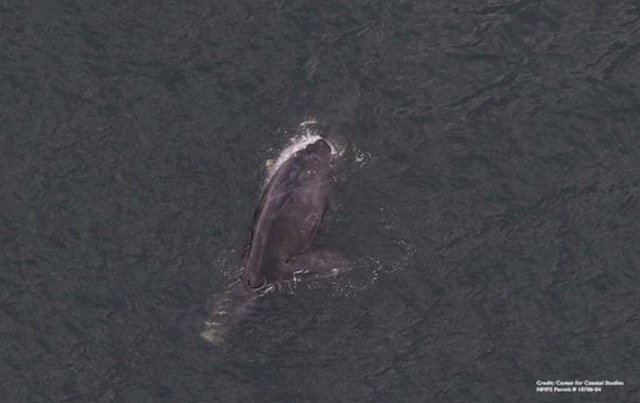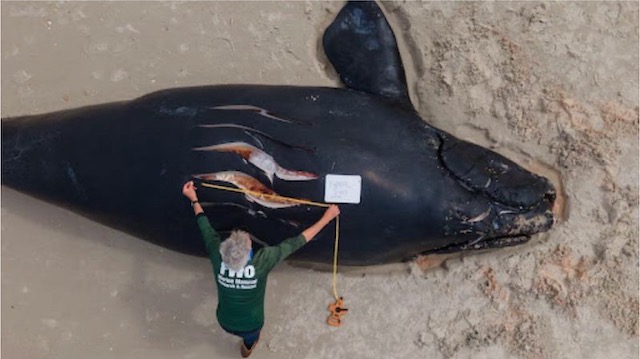The Right Whale: Modifying Fishing Fear And Slowing Vessel Speeds to Prevent Extinction
Where Is NJ Delegation & Conservation Support For Stronger NOAA Regulations?

Dead right whale found floating off New Jersey on June 25 shows sign of a vessel collision.
Photo: Center for Coastal Studies
I’ve been disturbed by how the marine mammal and whale stranding deaths have been framed by the media and opportunistically politicized – and in a partisan fashion that ignores ocean ecosystems.
So we are pleased to have a guest post today, by Susan Russell, Wildlife Policy Director, Animal Protection League of NJ. Susan is former VP of Friends of Animals and legislative liaison, Animal Welfare Institute. She led campaigns for NJ laws banning steel- jaw leghold traps and banning importation and sale of wild-caught birds, primarily psittacines, for the pet trade. Please read Susan’s essay:
[Update: 7/11/23 – a different version of Susan’s Op-Ed ran yesterday in the Asbury Park Press:
I’m told it ran in the Bergen Record too, but sorry no link. ~~~ end update]
“The right whales off our Atlantic coast are large, docile, and, despite centuries of carnage and persecution, friendly. They are also one of the most endangered whales in the world. Yet somehow, the crisis has been eclipsed by debates about wind power, even as the U.S. allows business interests to stymie emergency rules to forestall extinction.
North Atlantic right whales were the “right” whales to kill because they swim slowly and float after death. They never recovered from whaling; there are 340, or fewer, alive today, down from 481 in 2011. With only 70 breeding females left, the right whale will be functionally extinct by 2035.
The gravest human-caused threats to right whales, and to large whales globally, are entanglement in vertical-line, or rope, fishing gear, mainly for lobster and crabs, and collisions with vessels.
Right whale mothers and calves are especially vulnerable to vessel strikes and blunt force injury because they swim near the coast and the water’s surface.
As reported by the National Ocean and Atmospheric Administration (NOAA) in 2020, a right whale male calf near Cape May died of “several propeller wounds across the head and chest, and a likely skeg or rudder injury on the back that may have occurred at the same time. Based on observed evidence of healing, those wounds were likely several weeks old, but were serious enough that they may have significantly impaired the whale. The second vessel collision resulted in a series of propeller wounds and a skeg or rudder wound across the tail stock.” One calf, two vessel strikes.
Vessels of all kinds, from 35-foot recreational boats to tankers, can substantially reduce these losses simply by slowing down. In 2023 America, that appears too much to ask.
Most sailboats cruise at a speed of 4-6 knots (4.5-7 mph), with a top speed of 7 knots (8 mph or 13 km/h). Fishing trawlers go 8—10 knots; recreation and party boats like to go faster. In certain areas, and at certain times of the year, they will have to go slower.
Oceana, the global ocean protection organization, reports that Atlantic coast vessel non-compliance with speed restrictions can be as high at 90 percent in mandatory speed zones, and up to 85 percent in voluntary ones. Slowing speeds to 10 knots reduces a right whale’s risk of death by 80 to 90 percent.
Aiming to crack down on the deadly combination of noncompliance and speeding, last July, NOAA proposed regulations to expand 10-knot speed limit requirements to vessels 35-feet and above and establish mandatory closures in high-risk areas.
I saw speeding firsthand. My dad owned a wooden sailboat, a Tor 40 sloop named “Camelot,” and we cruised the Atlantic, to New England to Maryland, during the summers. Dodging wakes from, or being cut-off by, speeding “motorboats” was a chronic, and unprintable, gripe. My father believed that sailors were closer to the sea and understood and respected it. The lobbying against the rule seems to validate that belief.
As people risk their lives at sea to disentangle right whales from fishing gear, others block lifesaving regulations. NOAA (National Ocean and Atmospheric Administration) is delaying the vessel strike for a year rule due to “pressure” from the fishing and boating industries and recreational associations.
The Maine lobster industry and its four members Congress are aggressive, blocking all proposed emergency rules to prevent the extinction. (1) Worse, Congress seems to have ceded the whale’s fate to Maine’s politicians.
In 2021 a federal court found that NOAA had failed to protect the right whale under the Endangered Species Act (ESA) and ordered the agency to produce stricter rules by 2024.
In 2022, the Maine delegation led by Susan Collins (R) slipped a rider onto the 2023 budget bill that defied the federal court ruling and prevented the NOAA deadline and protective rule until 2028, when they will try to block it again.
With right whales dying off Cape May, there are no New Jersey members of Congress on Representative Raul Grijalva’s (D-Arizona) Rescue Whales Act to repeal Maine’s prohibition on protective regulations. Why not? (1)
Meanwhile, NOAA reports that continued use of present fishing gear and methods will allow entanglement to continue at levels at least five times higher than the North Atlantic right whale population could withstand.
The North American right whale is in an extinction crisis in real time. The hour is not coming, it’s here. Everyone who needs to must rise to meet it. When this whale is gone, who should have done what will not matter.
